|
|
|
Sort Order |
|
|
|
Items / Page
|
|
|
|
|
|
|
| Srl | Item |
| 1 |
ID:
139649


|
|
|
| 2 |
ID:
096512
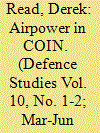

|
|
|
| 3 |
ID:
053081


|
|
|
|
|
| Publication |
May-June 1996.
|
|
|
|
|
|
|
|
|
|
|
|
|
|
|
|
| 4 |
ID:
138777
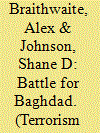

|
|
|
|
|
| Summary/Abstract |
The Iraqi Insurgency (2003–2011) has commonly been characterized as demonstrating the tendency for violence to cluster and diffuse at the local level. Recent research has demonstrated that insurgent attacks in Iraq cluster in time and space in a manner similar to that observed for the spread of a disease. The current study employs a variety of approaches common to the scientific study of criminal activities to advance our understanding of the correlates of observed patterns of the incidence and contagion of insurgent attacks. We hypothesize that the precise patterns will vary from one place to another, but that more attacks will occur in areas that are heavily populated, where coalition forces are active, and along road networks. To test these hypotheses, we use a fishnet to build a geographical model of Baghdad that disaggregates the city into more than 3000 grid cell locations. A number of logistic regression models with spatial and temporal lags are employed to explore patterns of local escalation and diffusion. These models demonstrate the validity of arguments under each of three models but suggest, overall, that risk heterogeneity arguments provide the most compelling and consistent account of the location of insurgency. In particular, the results demonstrate that violence is most likely at locations with greater population levels, higher density of roads, and military garrisons.
|
|
|
|
|
|
|
|
|
|
|
|
|
|
|
|
| 5 |
ID:
152022
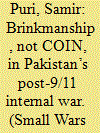

|
|
|
|
|
| Summary/Abstract |
Politics is critical to making sense of Pakistani successes and failures in dealing with non-state armed groups. This includes domestic political currents; regional political currents; and the global impetus of the post-9/11 era. How these currents overlap renders to any reading of insurgency in Pakistan real complexity. This article engages with this complexity rather than shirking from it. Its hypothesis is that while the insurgency bordering Afghanistan has been an epicentre of Pakistani military efforts to fight the Taliban, this theatre is in of itself insufficiently inclusive to grasp the nature of Pakistan’s security challenges and its consequent responses.
|
|
|
|
|
|
|
|
|
|
|
|
|
|
|
|
| 6 |
ID:
099551


|
|
|
| 7 |
ID:
111890


|
|
|
|
|
| Publication |
2012.
|
| Summary/Abstract |
Theories and counterinsurgency doctrines emphasize the importance of avoiding civilian casualties. Yet, many operations produce large numbers of so-called collateral civilian deaths. I present two competing arguments for when collateral deaths occur. One the one hand, they could be the unintentional result of offensives when trying to maintain force protection; on the other hand, they could be the result of a deliberate choice of relying on indiscriminate violence when pressured on the battlefield. I use new data on violence in Afghanistan 2004-2009, disaggregated by province and month, to examine what type of battlefield dynamics are more likely to produce high levels of collateral civilian casualties. The results show that civilian casualties are particularly high after counterinsurgency forces suffer losses in combat.
|
|
|
|
|
|
|
|
|
|
|
|
|
|
|
|
| 8 |
ID:
122393
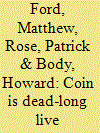

|
|
|
|
|
| Publication |
2012.
|
| Summary/Abstract |
Donald Rumsfeld was right. Force transformation works. The techniques
that led to the initial victories in Afghanistan in 2001 were precisely those
that produced success in Libya in 2011.1
Small-scale deployments of special
forces backed by precision strike and deep attack capabilities used to support an
allied indigenous armed group proved an effective military tool for achieving
specific strategic outcomes. In contrast, the results of large-scale troop deployments as part of counterinsurgency (COIN), stabilization and nation-building
activities over the past 1ten0 years in Iraq and Afghanistan have been less definitive. Despite intensive investment in blood, treasure, and military effort, the
precise long-term outcomes of these two campaigns remain unclear and will
be open to debate for years to come. This challenging operational experience
has, however, highlighted some necessary and enduring truths about the use of
military force. Despite great advances in military technology and the increasing
sophistication with which organized violence can be applied in a range of situations, all warfare remains characterized by uncertainty; there exists no silver
bullet that can guarantee enduring political success from the barrel of a gun.2
|
|
|
|
|
|
|
|
|
|
|
|
|
|
|
|
| 9 |
ID:
103846
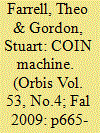

|
|
|
|
|
| Publication |
2009.
|
| Summary/Abstract |
This article assesses the British military effort in Afghanistan looking at three key elements in the campaign: strategy, military operations, and the inter-agency "Comprehensive Approach." We start by recognising the scale of the challenge that has faced the British: of all the provinces in Afghanistan, Helmand is the toughest to stabilize and secure. We then examine the evolution of all three elements above and find significant improvements in each: a flawed strategy has been corrected; the military have received more resources and become significantly better at COIN; and there is significant progress in the development of the inter-agency approach. In short, what the Americans will find in Helmand is a British COIN machine; a little creaky perhaps, but one that is fit for purpose and getting the job done. We briefly conclude on the prospects and the key to success: namely the development of a more coherent international strategy that accommodates the challenges posed by both Afghanistan and Pakistan.
|
|
|
|
|
|
|
|
|
|
|
|
|
|
|
|
| 10 |
ID:
154774


|
|
|
|
|
| Summary/Abstract |
Counterinsurgency (COIN) has long been recognised as a political phenomenon, but current theoretical understandings of politics in COIN reflect ideal types, overlooking the depth and complexity of the politics of insurgency and COIN. Drawing from India’s experience in its northeastern region, this article argues that COIN theory overlooks the political agency and multiplicity of actors, as well as overlooking the fundamentally political scope of interactions that take place between them. It calls upon COIN theorists to begin to map out this complex picture by urging greater integration between academics and practitioners studying COIN and theoretical inputs from wider academic disciplines.
|
|
|
|
|
|
|
|
|
|
|
|
|
|
|
|
| 11 |
ID:
131467
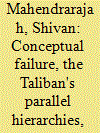

|
|
|
|
|
| Publication |
2014.
|
| Summary/Abstract |
ISAF exists to protect the Afghan constitutional model. This strategic objective will be defeated because the GIRoA model has a conceptual flaw that renders it incapable of delivering governance at the local level (Tier IV). This fatal flaw has enabled the Taliban, by developing parallel hierarchies, to displace GIRoA and establish itself in southern locales as the political authority. The Taliban are fighting a revolutionary war, a Maoist displacement strategy that uses guerrilla tactics to advance a political program. Petraeus and McChrystal failed to recognize the character of war, and believed the Taliban are pursuing an exhaustion strategy. They failed to devise a counter-RW strategy. The 'Surge' was doomed ab initio
|
|
|
|
|
|
|
|
|
|
|
|
|
|
|
|
| 12 |
ID:
107666
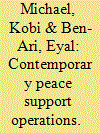

|
|
|
|
|
| Publication |
2011.
|
| Summary/Abstract |
In this article the authors examine two set of issues that constrain contemporary peace support operations (PSOs): one centered on the kinds of knowledge prevalent in PSOs and the second involving the organizational structures that characterize them. The authors' aim is to show the deep discursive and structural limitations and contradictions that continue to characterize the actions of armed forces and the dominance of militaristic thinking within PSOs. This article centers on multidimensional peacekeeping marked by emphasizing two main points in regard to the complex nature of such peacekeeping. First, Western military thinking is still dominant in the professional discourse of peacekeeping despite the fact that in many cases it is less relevant to the arenas where it is applied (in weakened or failed states). Second, forces in second-generation peacekeeping missions are by definition a form of hybrid organizations, and therefore conceptual changes in regard to PSOs not only involve the realm of knowledge but also entail practical consequences for the very organizational means used to achieve their aims. The authors' analysis demonstrates the blending, hybridization, and linkages that are an essential part of PSOs as processes that carry both advantages and disadvantages for organizational action.
|
|
|
|
|
|
|
|
|
|
|
|
|
|
|
|
| 13 |
ID:
128578
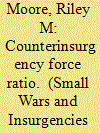

|
|
|
|
|
| Publication |
2013.
|
| Summary/Abstract |
As a consequence of intervention in Iraq and Afghanistan, force ratio for counterinsurgency (COIN) has come under increased scrutiny. Reduced to its essence, the issue is simply, 'How many troops does it take to get the job done?' This answer has been sought by the US military, academia, and think tanks. There have been numerous responses, culminating in several 'plug-and-play' equations for minimum force ratios in COIN operations. Due to the impossibility of determining precisely how many insurgent forces there are, it has become common to base force ratios on the population of the country. In the realm of policy, the question above is posed as, 'How many of our troops does it take to get the job done?
|
|
|
|
|
|
|
|
|
|
|
|
|
|
|
|
| 14 |
ID:
105995


|
|
|
|
|
| Publication |
2011.
|
| Summary/Abstract |
Counterinsurgency (COIN) has again emerged as a topic of both contemporary and historical interest in the age of what has been called a global counterinsurgency. However, little attention is being paid to the historical lineage of a COIN doctrine that is being rediscovered and promoted by an enthusiastic group of military intellectuals and commanders as the basis for US Army and Marine Corps doctrine. This article argues that historical claims for COIN success, based on courting popular gratitude by improving economic conditions, are at best anchored in selective historical memory, when not fantasy fabrications. The first argument of this article is that COIN does not constitute a distinct form of warfare, but merely a sub-set of minor tactics. Second, 'hearts and minds', so-called population-centric warfare, has seldom been a recipe for lasting stability. Rather, historically counterinsurgency succeeded when it has shattered and divided societies by severely disrupting civilian life. In fact, COIN is a nineteenth century legacy of empire whose uniqueness and impact was mythologized in its own day, and that is unlikely to prove a formula for strategic success in the twenty-first century.
|
|
|
|
|
|
|
|
|
|
|
|
|
|
|
|
| 15 |
ID:
124172
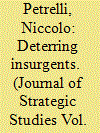

|
|
|
|
|
| Publication |
2013.
|
| Summary/Abstract |
This article studies the Israeli 'way of war' in counterinsurgency in the period 1987-2005 by analysing the characteristic features of Israel's approach and its ability to adapt to the challenges posed by the Palestinian and Lebanese insurgencies. It first outlines the evolution of the Israeli counterinsurgency. It subsequently examines the Israeli approach through the lens of the country's strategic culture, illuminating its features, rationales and goals, and concludes by examining to what extent Israel managed to adapt to the challenges of fighting insurgents.
|
|
|
|
|
|
|
|
|
|
|
|
|
|
|
|
| 16 |
ID:
099856
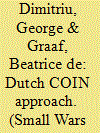

|
|
|
|
|
| Publication |
2010.
|
| Summary/Abstract |
Rarely has a military commitment led to such intense discussion in the Netherlands as the Task Force Uruzgan (TFU) mission in Afghanistan. In February 2010, the Netherlands' coalition government even collapsed after the two largest parties failed to agree on the withdrawal of Dutch troops from Afghanistan later this year. This article deals first of all with the difficult discussion over the Afghanistan mission of the TFU. The authors then subject three ISAF operations to close scrutiny. The authors provide some suggestions to help understand better this pivotal point in the execution of the whole operation and thus give a fuller picture of the Dutch counterinsurgency approach in Uruzgan.
|
|
|
|
|
|
|
|
|
|
|
|
|
|
|
|
| 17 |
ID:
132285
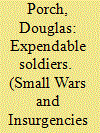

|
|
|
|
|
| Publication |
2014.
|
| Summary/Abstract |
Foreign Legions in the generic sense have evolved in ways that would surprise Beau Geste. Not only are more foreigners or recent immigrants enlisting in Western military forces, but also the post-Cold War era has seen the revival of warlord militias and Private Military Companies. Western militaries, in particular that of the United States, have also sought to increase their strategic reach through security assistance to regional military forces. While there have been some successes, security assistance has proven to have its limitations, not to mention unintended consequences for civil military relations, democracy promotion, and military efficiency.
|
|
|
|
|
|
|
|
|
|
|
|
|
|
|
|
| 18 |
ID:
091441
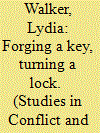

|
|
|
|
|
| Publication |
2009.
|
| Summary/Abstract |
Counterinsurgency (COIN) doctrine is designed to combat a defined insurgency. In the present situation in Iraq, COIN's definition has been radically extended to include nation-building as well. This additional function has expanded the scope of the role of the Coalition Forces in Iraq. Yet COIN in its present incarnation may not be enough to finalize the implementation of the strategy of nation-building. This article finds three main criticisms/limitations of contemporary COIN strategy: (1) It is predicated on a classic notion of insurgency that looks very different from present conflicts. (2) Although COIN advocates a political solution to a political problem, it uses (by default) mainly military mechanisms to carry it out. (3) Completion of the intricate and ambitious tasks necessary to defeat insurgencies in foreign lands may lie outside the direct control of the United States.
|
|
|
|
|
|
|
|
|
|
|
|
|
|
|
|
| 19 |
ID:
132282
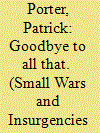

|
|
|
|
|
| Publication |
2014.
|
| Summary/Abstract |
This article reflects on a decade of British counterinsurgency operations. Questioning the idea that lessons have been learnt, the paper challenges the assumptions that are being used to frame future strategic choice. Suggesting that defence engagement is primarily focused on optimising overseas interventions while avoiding a deeper strategic reassessment about whether the UK should be undertaking these sorts of activities, the article calls for a proper debate on Britain's national security interests.
|
|
|
|
|
|
|
|
|
|
|
|
|
|
|
|
| 20 |
ID:
112635
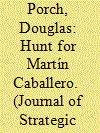

|
|
|
|
|
| Publication |
2012.
|
| Summary/Abstract |
While the success of Colombia's fight against illegal armed groups, led by Fuerzas armadas revolucionarias de Colombia - ejército del pueblo (FARC-EP), is generally lauded as evidence of the effectiveness of both COIN doctrine and security assistance, the configuration of Colombia's counter-insurgency effort remains largely unstudied. This article will explain the success of one of those campaigns carried out principally by the Colombian marines (Colmar) in an area of northern Colombia known as the Montes de María. Contingent factors shaped the success of this campaign, beginning with the fact that the Montes de María forms an area where insurgents, relative late comers to the region, found it difficult to put down deep roots. However, operations to eradicate them were complicated by the inexperience of the Colmar, and by constraints placed by Colombia's Constitutional Court on COIN methods modeled on those successfully applied by the British in Malaya and Kenya. Therefore, Colmar officers initiated their five-year campaign by building up a base of popular support in the towns and targeting insurgent logistical networks. This bought time to strengthen the Colmar's combat and intelligence capabilities, and take the offensive that eventually isolated and killed the leader of the FARC in the Montes de María, Martín Caballero. Unfortunately, the failure of the Colombian government to follow up the Colmar victory by installing a regional and local governments viewed as legitimate by the population, and to resolve long standing land tenure issues, has meant that, so far, the Colmar looks to have delivered a tactical victory in a strategic vacuum.
|
|
|
|
|
|
|
|
|
|
|
|
|
|
|
|
|
|
|
|
|